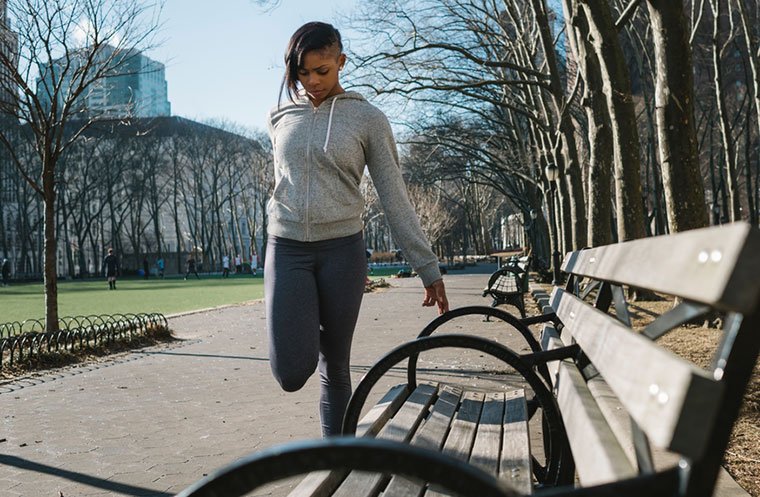Yoga is the best workout you can start performing because it provides amazing results. It is easy to do and can be done in the comfort of your home as a beginner.
Although it may seem mild, yoga can help you reach a better body fitness and reduce body weight, if you are consistent with your yoga practice. It will also promote relaxation, stress reduction, and will improve the processes of your organism, for a better state of health.
You simply have no reason not to start practicing yoga today. If going to the gym or performing other types of physical activities do not seem to be too attractive in your case. If you never practiced yoga before, it would be recommended to start with some easy yoga poses for beginners first. So you’ll get used to it.
The following 7 basic simple yoga poses will help you get started and can be performed at home whenever you have some spare time.

7 Easy Best Yoga Poses for Beginners At Home
1. The Cat and Cow Pose

This is a basic yoga position that is also used for stretching your back and relieving back pain, especially in the case of people that spend a lot of hours sitting down at a desk. It is one of the easy yoga poses for beginners that will improve your mobility and get rid of tension in your back and middle section.
How To :
- To perform it, put your hands and knees on the floor, keeping your back in a relaxed position.
- Inhale deeply and, as you exhale, curve your spine outwards, toward the ceiling, while tucking your chin in your chest.
- Inhale again and when exhaling, arch your back in the opposite direction, by gently raising your head and looking upward.
2. The Downward Facing Dog
This a simple yoga pose should be performed after the Cat Pose because the previous pose gets the body ready for this particular pose. And this is one of the best daily yoga for beginners.The yoga pose will help you stretch almost your entire body, also allowing you to relax.
How To:
- Start by standing on your hands and knees, with the fingers of your palms facing forward and the palms positioned just past your shoulder line.
- Now raise your bottom until your body forms a V shape, making sure your legs and arms are stretched.
- The feet should be positioned hip-wide and, while supporting your body with your hands, move your chest toward your legs.
3.The Mountain Pose
While it is one of the easy yoga poses for beginners, the Mountain Pose is also considered one of the most basic poses in yoga, so you must learn how to perform it. It will help you learn how to balance your body, aligning it right, while also raising awareness of your entire being.
How To:
- Stand up straight, having your feet together and your arms hanging next to your body.
- Make sure your feet stand solidly on the ground because they will take your entire body weight.
- Make sure to keep your back straight, using a wall at first to make sure you’re doing it right.
- Your ankles, hips, shoulders, and ears should be all aligned.
- You can keep your hands around your body or raise them above your head, pushing your shoulder blades against each other, while keeping the palms inward, toward each other.
4. The Child Pose
With the help of this yoga pose, you will manage to relax, finding your moment of peace. Consider this one of the easy yoga poses for beginners made to offer you a break because it helps with relaxing your nervous system.
How To:
- Start by kneeling, tucking your toes under your bottom. If your knees are giving you a hard time, get into the position gently.
- Then bend your body forward, reaching your arms in front of you, and lowering your head until your forehead meets the yoga mat.
- Your palms should lay flat on the ground and your chest should rest comfortably on your thighs.
5. The Warrior I Pose
This position will help tone the muscles of your legs while helping you stretch your arms and legs. It will also help you increase focus and balance. Start it by getting into the Mountain Pose.
How To:
- Take a deep breath and, as you exhale, put your left leg back so that you end up in a lunge position.
- The right knee should be above your right ankle.
- Put your arms up and make sure they align with your ears.
- Your left foot should be positioned at a 90-degree angle so that your left ankle is perpendicular to your right ankle.
- Your chest and shoulders should be expanded back and hips kept square as you continue breathing throughout this pose.
Read Next: Top 8 Yoga Poses You Should Start Doing Today
6. The Warrior II Pose
This is another one of the easy yoga poses for beginners, part of the Warrior yoga pose group. It is very similar to the first Warrior pose. Although this time your body is positioned on the side, not forward.
This will work your hip flexor muscles, improving your flexibility.
How To:
- Start this in the same manner, by taking the Mountain Pose.
- Take one foot back and make sure it is perpendicular to the foot up front.
- Raise your arms until they are in the same line with your shoulders, keeping them parallel to the ground.
- Bend the knee of your front foot until it lies above the ankle, and move your head toward your front stretched arm, looking in that direction.
7. The Sukhasna Pose
This is a pose ideal for meditation, helping you get centered and relaxed as well.
How To:
- Sit down on the yoga mat and cross your legs, tugging your left leg under the right thigh and the right leg under your left thigh.
- Your spine should stay straight and your hands positioned on your knees.
- Now gently relax and start breathing in a calm manner.
Yoga is a great way to exercise, tone, and stretch your body, while also reducing tension and stress. So often induced by a busy lifestyle. You can perform yoga at home, on the beach, in a meadow, anywhere you feel like it and anywhere you want, without having to attend yoga classes all the time.
So, are you ready to make a positive change in your life? Then start by performing these easy yoga workout that was specially picked for beginners.
It is your health and well-being at stake, so don’t postpone it any longer. Make yoga a constant presence in your life today and you will immediately feel better and look better if you remain consistent.
Original article and pictures take www.blackdiamondbuzz.com site










































